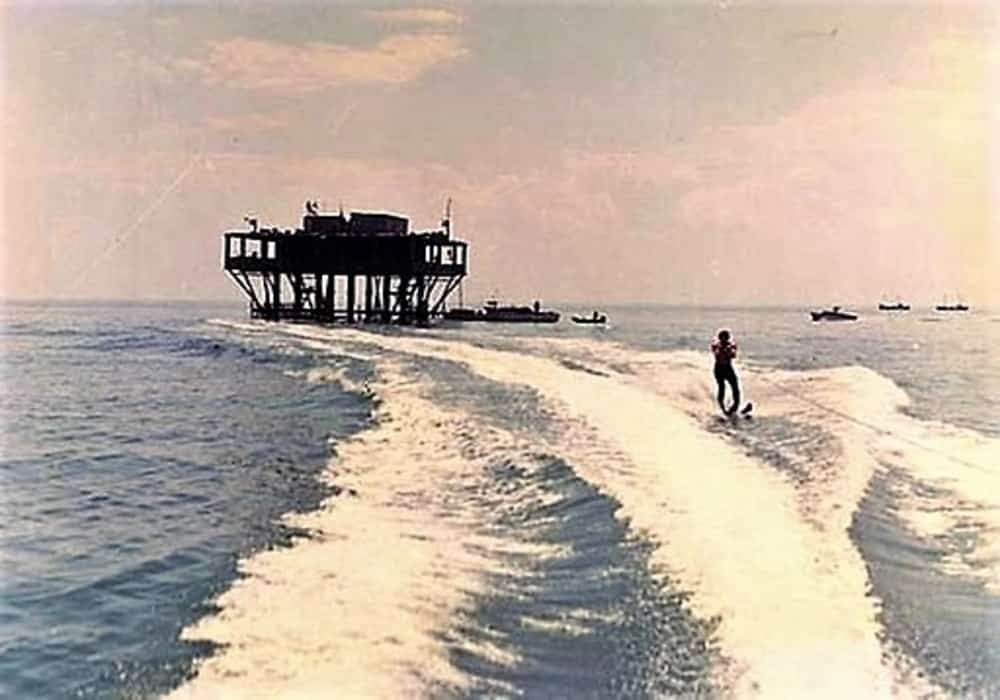Rose Island
Rose Island was a short-lived micronation on a man-made platform in the Adriatic Sea, 11 kilometres (6.8 mi) off the coast of the province of Rimini, Italy.
Short real history
As the year 1968 turned the world upside down, off Rimini, in the middle of the sea, rose the island of roses. Rose Island (Micronation) was a micronation on an artificial platform in the Adriatic and was eleven kilometers ahead of Rimini in Italy.
A dream of emancipation, a utopia with Romagna sauce? The Isle of Roses was certainly a curious political, social and cultural experience. In the summer of 1968, Giorgio Rosa, an eccentric engineer from Bologna, inaugurated a tin and cement structure located in international waters, some 11 kilometers from the Romagna coast. The platform was to be, in its intentions, a micro-nation with its president, its ministries, its autonomous language (Esperanto) and its national anthem (The Ghost Ship by Richard Wagner). Its dimensions were relatively limited: around 400 square meters. In practice, the area of a hotel, a bank, a bar and a dock for boats. Yet the Insulo de la rozoj, as it was called in Esperanto, managed to stand up to the world for a whole summer.
Read also: Chernobyl (Ukraine) History and Disaster of Nuclear Contamination
Name
The entity that would settle on the artificial platform was given the Esperanto name of Libera Teritorio de la Insulo de la Rozoj (Emitian: Libero Territorio dell’Isola delle Rose), which later became Esperanta Respubliko de la Insulo de la Rozoj (Esperanto Republic of the Island of Roses). His official journal was titled Osservatore Domenicano , published in collaboration with the Dominican priests of Bologna, to whom Rosa was closely linked.
It is believed that the term Esperanto Rozoj (Italian: rose) was borrowed from the nickname Giorgio Rosa, designer and builder of the artificial platform, also creator and inspirer of the state entity, as well as his desire to “see roses bloom in the sea”.
History of Rose Island
In 1967, the Italian engineer Giorgio Rosa built a 400 square meter platform, supported by nine pylons, on which he maintained, among other things, a restaurant, a bar, a nightclub, a souvenir shop and a post office.
On the 24th June 1968 Rosa declared the independence of the island under the Esperanto name “Insulo de la Rozoj” and declared himself president. Soon after, the Republic of Rose Island issued a number of stamps and had its own currency with Mill.
The Italian authorities accused Giorgio Rosa of attracting tourists and evading taxes with Rose Island. A unit of the Copieri finally landed on the platform and took control. The “Government Council” is said to have previously sent a telegram, probably to the Italian government, to protest against the “violation of its sovereignty and the obstruction of tourism by the military occupation”.
On the 13th February 1969 the Italian navy destroyed the plant with explosives, which was processed by a stamp of the government in exile pink. Allegedly, there was a dead person during the destruction; probably Rosa’s dog was on the platform during detonation.
Giorgio Rosa died in 2017.
The creation of the platform
In 1958, the Bolognese engineer Giorgio Rosa decided to build a frame of steel pipes well welded to the ground, to be transported floating up to the chosen point (outside the Italian territorial waters) and installed. The SPIC: Società Sperimentale per Iniezioni di Cemento (Experimental Society for Cement Injections) was therefore established, with the president Gabriella Chierici, wife of the engineer and technical director.
The first inspection of the chosen point, off the coast of Rimini, about 11.5 km from the coast, took place between July 15 and July 16, 1958, using a sextant (reflective navigation instrument for measuring the angular distance between two points both vertically and horizontally) and aligning itself with the lighthouse of the Rimini skyscraper.
Giorgio Rosa hypothesized for the laying of his island to raise the shallow seabed with a system of dredging the sand retained by algae. The inspections took place using a boat, built in steel and propelled by an engine of a Fiat 500, and continued throughout the summer of 1960, every two weeks, based on a shed on the Rimini pier.
In the summer of 1962, however, due to technical and financial problems, the company stopped; moreover, in October of the same year, the Italian authorities ordered the removal of any obstacle to navigation.
On May 30, 1964, the Port Authorities of Rimini, Ravenna and Pesaro were contacted, respectively, to option the spaces on the quay, for the supply of diesel and for the construction of the island structure at the shipyards and for the publication of the notice to mariners for reporting the presence of structures.
Sources: PinterPandai, Engineering, Visit Rimini, Aquae
Photo credit: Wikimedia Commons
Photo explanations: Esperanto Republic of the Isle of the Rose (micronation), near Italy, in 1968



